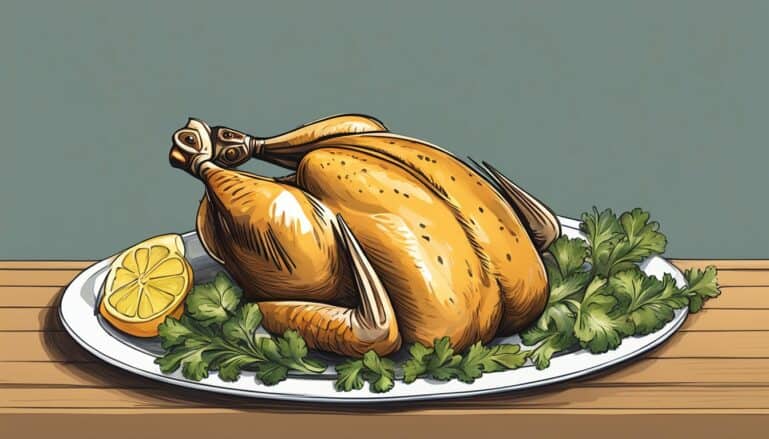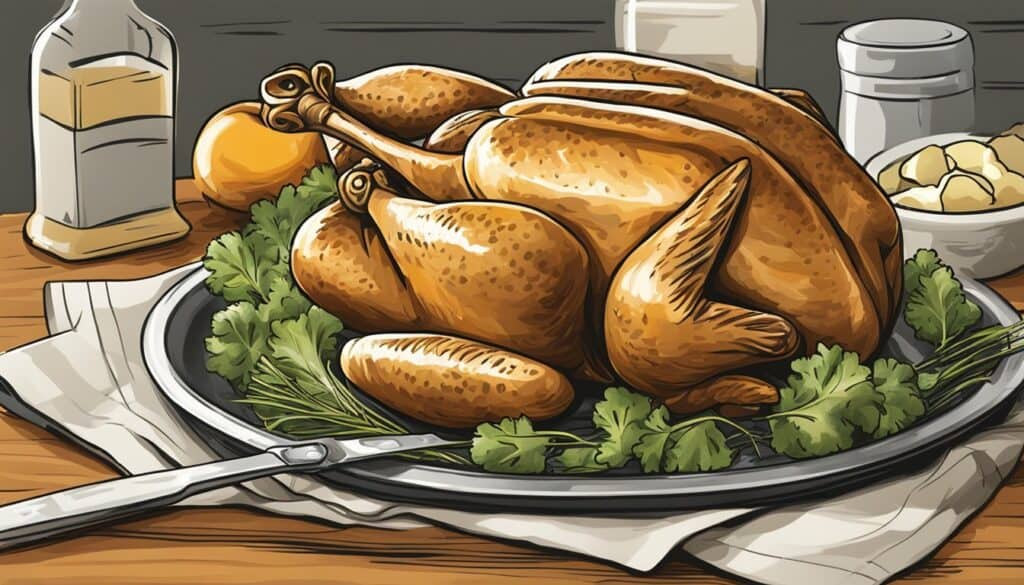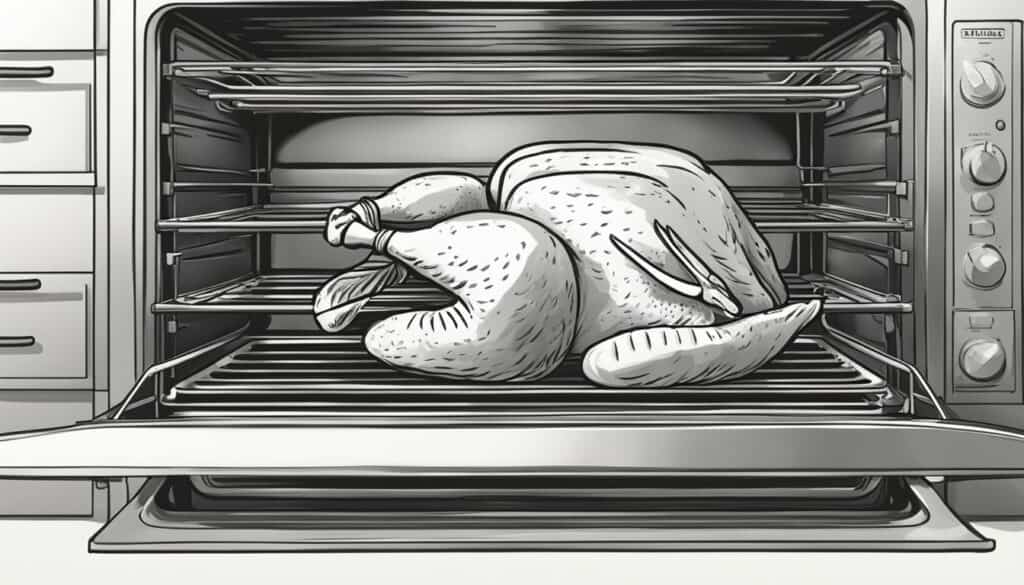How to Cook Cornish Hen: A Step-by-Step Guide

Table of Contents
Understanding Cornish Hen
Cornish hens are a breed of chicken that are often used for cooking due to their tender meat and mild flavor. They are small in size, typically weighing between 1-2 pounds, and are often served as individual portions.
The Cornish hen was first developed in the United States in the 1950s by crossing a Cornish game bird with a White Plymouth Rock chicken. This resulted in a bird that had a larger breast and more tender meat than traditional game birds.
Cornish hens are often confused with broiler chickens, which are another breed of chicken that is commonly used for cooking. However, broiler chickens are typically larger and have a more robust flavor than Cornish hens.
When selecting Cornish hens for cooking, it is important to choose birds that are fresh and have not been frozen. Frozen Cornish hens can be tough and dry when cooked.
Overall, Cornish hens are a versatile and delicious option for cooking, whether you are roasting, grilling, or braising them.
Choosing and Preparing Cornish Hen
When it comes to cooking Cornish hen, it’s important to start with a quality bird. I recommend choosing a fresh, organic Cornish hen that weighs around 2 pounds. This size is perfect for serving one or two people, making it a great option for a special dinner or date night.
Before cooking, it’s important to properly prepare the Cornish hen. Here are a few tips:
- Remove the giblets: Check inside the cavity of the Cornish hen and remove any giblets or organs that may be inside.
- Rinse and pat dry: Rinse the Cornish hen under cold water and pat it dry with paper towels. This will help remove any excess moisture and ensure a crispy skin when cooking.
- Season well: Season the Cornish hen generously with salt, pepper, and any other herbs or spices you prefer. This will help enhance the flavor of the bird.
Once your Cornish hen is prepped and ready to go, it’s time to start cooking. Whether you choose to roast, grill, or bake your Cornish hen, the key is to cook it until it reaches an internal temperature of 165°F. This will ensure that the bird is fully cooked and safe to eat.
Overall, cooking Cornish hen is a simple and delicious way to impress your guests or treat yourself to a special meal. With a little preparation and the right cooking techniques, you can create a flavorful and juicy Cornish hen that is sure to please.

Preheating the Oven
Before cooking the Cornish hen, it’s important to preheat the oven to ensure that it cooks evenly. Preheating the oven is a simple process that can help you achieve the perfect texture and flavor for your Cornish hen.
To preheat the oven, follow these steps:
- First, set the oven temperature to the required temperature, which is typically 375°F for Cornish hen.
- Allow the oven to preheat for at least 10-15 minutes before placing the Cornish hen inside.
- During the preheating process, it’s important to ensure that the oven door is closed to maintain the temperature and prevent heat loss.
- Once the oven has reached the desired temperature, you can place the Cornish hen inside and begin cooking.
Preheating the oven is an essential step that should not be skipped. It ensures that the Cornish hen cooks evenly and thoroughly, resulting in a delicious and flavorful meal.
Seasoning the Cornish Hen
Using Salt and Pepper
To bring out the natural flavors of the Cornish hen, I always start with a generous sprinkle of kosher salt and freshly ground black pepper. Make sure to season both the inside and outside of the bird for maximum flavor.
Incorporating Herbs
Herbs like rosemary and thyme complement the delicate flavor of the Cornish hen nicely. I like to mix chopped herbs with softened butter and rub it under the skin of the bird before roasting. Alternatively, you can sprinkle dried herbs over the bird before cooking.
Adding Citrus Flavors
Lemon or lime zest can add a bright, fresh flavor to the Cornish hen. Rub the zest over the skin of the bird before cooking, or stuff the cavity with lemon or lime wedges for a burst of citrus flavor.
Creating a Garlic Blend
Garlic lovers, rejoice! A garlic blend can add a wonderful depth of flavor to the Cornish hen. Mix minced garlic with softened butter and herbs, and rub it under the skin of the bird before roasting. Alternatively, you can stuff the cavity with garlic cloves for a more intense garlic flavor.
Remember to always taste as you go and adjust seasoning as needed. With these simple seasoning tips, your Cornish hen will be bursting with flavor!
Stuffing the Cornish Hen
To start, I like to prepare the stuffing for the Cornish Hen. I find that wild rice stuffing is a great option, as it pairs well with the flavor of the hen. Here’s how I prepare the stuffing:
-
Start by cooking 1 cup of wild rice according to the package instructions. Once cooked, set aside.
-
In a separate pan, sauté 1 chopped onion and 2 stalks of chopped celery until they are tender.
-
Combine the cooked wild rice with the sautéed onion and celery mixture.
-
Add salt and pepper to taste.
-
If desired, you can also add other herbs and spices to the stuffing mixture, such as thyme or sage.
Now that the stuffing is prepared, it’s time to stuff the Cornish Hen. Here’s how I do it:
-
Preheat the oven to 375°F.
-
Rinse the Cornish Hen and pat it dry with paper towels.
-
Spoon the stuffing mixture into the cavity of the Cornish Hen, packing it in tightly but not overfilling it.
-
Use kitchen twine to tie the legs of the Cornish Hen together.
-
Place the Cornish Hen in a baking dish and roast in the preheated oven for approximately 1 hour and 15 minutes, or until the internal temperature of the hen reaches 165°F.
And there you have it – a delicious and flavorful Cornish Hen with wild rice stuffing.
Roasting the Cornish Hen
To roast a Cornish hen, I first preheat the oven to 425°F (218°C). Then, I prepare the hen by rinsing it under cold water and patting it dry with paper towels. I season the hen with salt, pepper, and any other desired herbs and spices.
Next, I place the hen breast-side up on a roasting rack in a roasting pan. This allows the heat to circulate evenly around the hen and helps the skin to crisp up. If a roasting rack is not available, I can also place the hen directly on the pan.
I then roast the hen in the preheated oven for approximately 45-55 minutes, or until the internal temperature of the thickest part of the meat reaches 165°F (74°C). I baste the hen with its own juices or melted butter every 15-20 minutes to keep it moist and flavorful.
Once the hen is fully cooked, I remove it from the oven and let it rest for 10 minutes before carving. This allows the juices to redistribute throughout the meat and makes it more tender and juicy.
Roasting a Cornish hen is a simple and delicious way to enjoy this flavorful bird. With a few basic steps and some added seasoning, you can create a mouthwatering meal that is sure to impress your guests.

Checking the Temperature
To ensure that the Cornish hen is cooked to perfection, it’s essential to check its internal temperature. I always use a meat thermometer to do this, and I recommend that you do too.
Here’s how to check the temperature of your Cornish hen:
- Insert the thermometer into the thickest part of the hen, making sure not to touch the bone.
- Wait for the thermometer to stabilize, which usually takes around 15 seconds.
- Check the temperature on the thermometer display.
The USDA recommends cooking poultry to an internal temperature of 165°F (74°C) to ensure that it’s safe to eat. When checking the temperature of your Cornish hen, make sure it has reached this temperature.
If you don’t have a meat thermometer, you can also use an instant-read thermometer. However, be aware that instant-read thermometers aren’t as accurate as meat thermometers, and you’ll need to check the temperature in a few different spots to ensure that the hen is cooked through.
When your Cornish hen is fully cooked, the juices should run clear. If the juices are still pink, then the hen needs to cook for a little longer.
In summary, checking the temperature of your Cornish hen is an essential step to ensure that it’s cooked to perfection and safe to eat. Use a meat thermometer or an instant-read thermometer to check the temperature, and make sure it has reached 165°F (74°C).
Resting and Serving the Cornish Hen
Once the Cornish hen is cooked, it is important to let it rest for a few minutes before serving. This allows the juices to redistribute throughout the meat, making it more tender and flavorful. I recommend letting the hen rest for at least 5-10 minutes before serving.
When it comes to serving, there are a few options. You can serve each hen whole, or you can cut it into halves or quarters. If you choose to cut it, I recommend using kitchen shears to make the process easier.
For a date night or a special occasion, you can also add a garnish to make the dish more visually appealing. Some popular options include chopped herbs, lemon wedges, or even edible flowers.
Here are a few tips to keep in mind when serving Cornish hen:
- Use a sharp knife or kitchen shears to cut the hen into pieces.
- Arrange the pieces on a platter or individual plates.
- If desired, add a garnish to the dish.
- Serve immediately.
Overall, Cornish hen is a delicious and versatile dish that can be enjoyed on many occasions. By following these tips, you can ensure that your hen is perfectly cooked and presented.
Accompaniments for Cornish Hen
When it comes to serving Cornish hen, there are a variety of side dishes that can complement its rich flavor. Here are some of my favorite accompaniments:
Roasted Potatoes
Roasted potatoes make for a classic and simple side dish that pairs well with Cornish hen. Cut the potatoes into small wedges and toss them with olive oil, salt, and pepper before roasting them in the oven.
Carrots and Vegetables
Roasted carrots and vegetables are a colorful and healthy option to serve alongside Cornish hen. Toss them with olive oil, garlic, and your favorite herbs before roasting them in the oven.
Zucchini
Zucchini is a light and refreshing side dish that pairs well with Cornish hen. Slice the zucchini into rounds and sauté them in a pan with garlic and olive oil.
Sweet Potatoes
Sweet potatoes are a delicious and nutritious option to serve alongside Cornish hen. Cut the sweet potatoes into cubes and toss them with olive oil, salt, and cinnamon before roasting them in the oven.
Mashed Potatoes
Mashed potatoes are a classic and comforting side dish that pairs well with Cornish hen. Boil the potatoes until soft, then mash them with butter, milk, and your favorite seasonings.
Overall, there are many ways to serve Cornish hen, and these accompaniments are just a few delicious options to consider.
Nutritional Information
As someone who is health-conscious, I always make sure to check the nutritional information before cooking any meal. Cornish hen is a great source of protein, but it’s important to be aware of the other nutrients it contains as well. Here’s a breakdown of the nutritional information for a typical serving of Cornish hen:
- Calories: A 3.5 oz serving of Cornish hen contains around 165 calories.
- Protein: Cornish hen is a good source of protein, with a 3.5 oz serving containing around 23 grams of protein.
- Cholesterol: A 3.5 oz serving of Cornish hen contains around 80mg of cholesterol.
- Saturated Fat: Cornish hen is relatively low in saturated fat, with a 3.5 oz serving containing around 2.5 grams.
- Carbohydrates: Cornish hen is low in carbohydrates, with a 3.5 oz serving containing less than 1 gram.
- Sodium: A 3.5 oz serving of Cornish hen contains around 70mg of sodium.
Overall, Cornish hen is a nutritious and tasty meal option. Just be sure to keep an eye on portion sizes and pair it with some healthy sides for a well-balanced meal.
Alternative Cooking Methods
When it comes to cooking Cornish hen, there are many methods to choose from. While roasting is the most common method, there are other ways to prepare this delicious bird.
Grilling Cornish Hen
Grilling is a great option for those who want to enjoy the outdoors while cooking their Cornish hen. To grill a Cornish hen, follow these simple steps:
- Heat your grill to medium-high heat.
- Season your Cornish hen with your favorite spices and herbs.
- Place the hen on the grill, breast-side down.
- Grill for 10-12 minutes, then flip the hen over and grill for an additional 10-12 minutes.
- Use tongs to remove the hen from the grill and let it rest for a few minutes before serving.
When grilling a Cornish hen, it’s important to use indirect heat to prevent the meat from drying out. You can also use a meat thermometer to ensure that the internal temperature of the hen reaches 165°F.
Spatchcocking Cornish Hen
Spatchcocking is a technique that involves removing the backbone of the bird and flattening it out before cooking. This method is great for ensuring even cooking and crispy skin. To spatchcock a Cornish hen, follow these steps:
- Use kitchen shears to cut along both sides of the backbone and remove it.
- Flip the hen over and press down on the breastbone to flatten it out.
- Season the hen with your favorite spices and herbs.
- Roast in the oven at 425°F for 25-30 minutes, until the internal temperature reaches 165°F.
Spatchcocking a Cornish hen can also make it easier to carve and serve. Plus, it’s a great way to impress your guests with your culinary skills.
Overall, grilling and spatchcocking are both great alternatives to roasting when it comes to cooking Cornish hen. They’re easy, delicious, and can be a great way to switch up your usual cooking routine.